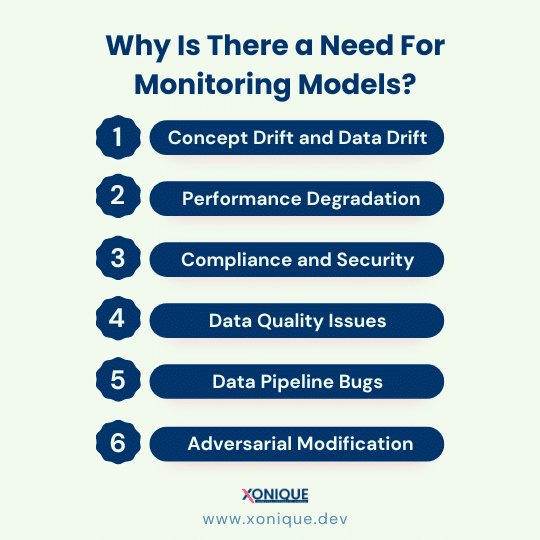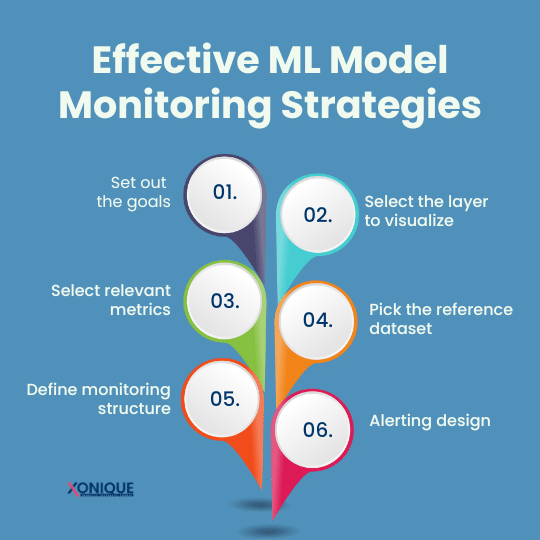What Is Monitoring Machine Learning Models?
Monitoring models that use machine learning in production is a continuous process of observing and analyzing the effectiveness and behavior of the models after they have been placed in an actual-world setting. This helps to identify anomalies, deviations, and other issues that could occur over time. A continuous live view should allow stakeholders to assess how the model performs in a context to determine when it is best to upgrade a model in production. This ensures that your model is running as it should. The best visibility into the model you have deployed will help you identify any problems and their sources before they cause adverse business effects. It may seem easy, but it’s more complex. Monitoring machine learning models isn’t easy. This section will examine the difficulties in monitoring machine learning models in depth. As in the credit risk prediction model, monitoring involves monitoring various indicators such as precision, accuracy, recall, and F1 score. Furthermore, it will examine the pattern of input feature distribution and forecasts to ensure they are consistent with the information used to train.
Why Is There a Need For Monitoring Models?
The creation of a machine learning model is only the beginning. When that model is put into the real world, it will face various problems that hinder its performance and require constant surveillance.
Concept Drift, And Data Drift
Data in the real world constantly changes, and its underlying patterns can alter over time. Concept drift results from the relationship between input elements and the desired variable changes. Data drift results from the event that the pattern of features in input shifts. Monitoring can detect shifts in these features and allow for prompt modeling updates.
Performance Degradation
Even trained AI ML Models can suffer an increase in performance due to changes in user behavior, external triggers, and the addition of new information. Regular monitoring helps to identify these issues and prompts corrective measures.
Compliance And Security
In healthcare or finance, where regulators’ compliance is essential, the monitoring process ensures that models operate according to ethical and legal standards. This helps prevent unintentional biases and ensures that models function within the boundaries of their respective fields.
Issues With Data Quality
Data quality covers various issues related to input data quality, accuracy, and quality. For instance, missing values, duplicate records, and shifts affect the feature range: Imagine milliseconds being replaced by seconds. If a model gets unreliable inputs, it’s likely to make unreliable predictions.
Data Pipeline Bugs
Many errors occur during data processing. The resulting bugs could cause delays in data processing or information that does not conform to the intended format, which can cause problems with the model’s performance. In particular, a glitch during data processing could lead to features that have the wrong format or do not align with the input schema.
Adversarial Modification
External actors could deliberately attack and alter the model’s performance. In particular, spammers could modify and discover ways to defeat spam detection systems. When using LLM models, shady actors deliberately provide data inputs for manipulating the model’s outputs with techniques such as prompt injection. Most of the time, there’s the possibility of a series of machine learning models in operation. If one model produces incorrect results, it may spread downstream, causing a drop in the model’s quality for the dependent model. If the issues arise during production models, they could result in incorrect outputs. Based on the application, making the wrong prediction can have negative consequences. The risk ranges from loss of profits and customer dissatisfaction to reputational harm and operational interruptions. The more critical a model is to the company’s growth, the more effective surveillance is required.
What ML Model Monitoring Is Hard?
There is a long-standing practice of monitoring the health of software and its performance. How does ML monitor for model health differently? Do you think it is possible to apply the same techniques? Although checking the system’s health is still necessary in part, Model monitoring has specific challenges, making it an entirely separate area. Initially, you are focused on various indicators, like data quality and model indicators. The method you use to calculate these metrics and create your model monitoring is distinct. Let’s take a look at the various issues.
Silent Failures
Most software issues are visible when things aren’t working, and you’ll get the error code. Machine learning is a process that could encounter various types of mistakes, such as a model giving an incorrect or untrue prediction. These errors are “silent”: a model generally responds if it can handle the data inputs. The model can provide a low-quality forecast without alarm if the input information is erroneous or substantially different. To identify such “non-obvious” errors, you have to assess the model’s reliability with proxy signals and design particular validations.
Inaccurate Or False
In an ML-based production system, the feedback about model performance typically takes a while. Due to this, you can’t gauge the model’s actual performance in real-time. If, for instance, you are forecasting sales for the week ahead, it is only possible to estimate how well the model performs once the time has passed and you are aware that the sales figures are known. To evaluate the quality of the model indirectly, you must observe the inputs to the model as well as the outputs. In most cases, you will require two loops of monitoring, which are real-time and utilize proxy metrics, and the delay loop runs when the label information is readily available.
Qualities Are Defined As a Relative Term
The quality of model performance is contingent upon the particular issue. A 90% accuracy may be an excellent performance for one model but an indication of a significant problem with the quality of another model or a lousy measurement decision in the case of the third. In addition, there is an inherent variance in the performance of models. It isn’t easy to establish clear, universal parameters and alerting thresholds. It is necessary to modify your approach based on application, the cost of error, and the economic impact.
Tests For Complex Data
These metrics can be extremely complex and highly computationally demanding. You could, for instance, test the distribution of inputs through statistical tests. This involves collecting critical dimensions and passing them on to a reference dataset. The design of the technology is different from traditional monitoring software, in which a software system is expected to continuously release metrics such as latency.
The Most Important Thing To Monitor During Production
Monitoring can be divided into two stages: functional and operational.
Functional Level Monitoring
On the operational scale, data scientists or machine learning engineers monitor three distinct areas: the information input, the models, and the output forecasts. Monitoring each category will provide data scientists with more insights into the effectiveness of their model.
Input Data
Models are dependent on data provided as input. It could fail when a model is exposed to input that it doesn’t expect to receive. Monitoring input data is the first step towards detecting problems with functional performance and putting them out before affecting the effectiveness that the system uses to learn. The items to watch out for from a perspective of input data comprise:
Data Quality
To ensure data integrity, you must verify the integrity of your data in production before introducing it into the machine learning model using its characteristics. Also, make sure that the data types you use are comparable. Various reasons could cause data integrity issues, such as an alteration in the data schema or data deletion. These issues alter the data pipeline, so the model doesn’t receive all the expected data.
Data Drift
The distribution of producing and training data could be tracked to determine whether it is drifting. This can be accomplished by monitoring variations in the features’ statistical properties as time passes. The data comes from an inexhaustible, changing source known as the world of reality. If people’s habits change, the environment and the environment surrounding the business problem you’re working on could change. When that happens, you should refresh your machine-learning models.
The Model
The heart of your machine learning program is your computer model. The model should maintain a specified limit for the machine learning system to generate economic value. Many factors that could hinder the model’s performance must be managed to accomplish the goal. This includes the model’s drift and versions.
Model Drift
Model drift refers to the decline of a model’s predictive power due to changes in the real world. Statistical tests are recommended to identify drift, and predictive power should be assessed to assess a model’s effectiveness as time passes.
The Output
Knowing the models’ results within the manufacturing environment is necessary to understand how the model works. The machine learning model is implemented to address problems. Monitoring the model’s output can be required to ensure it’s performing according to the parameters used to calculate KPIs.
Truth In The Ground
If you encounter specific issues, there are Ground Truth labels. For example, suppose models are used to recommend personalized ads to customers (you predict whether users will click on the advertisement or not). You can quickly obtain factual information if someone convinces the user that the ad is attractive. In these situations, the aggregation of the model’s predictions could be compared against actual solutions to assess how the model performs. But, testing model predictions against labels that are ground truth isn’t easy for the majority of applications of machine learning, which is why a different approach is needed.
Prediction Drift
The predictions must be tracked if getting the ground truth label is impossible. If there’s a significant shift in the pattern of forecasts, it could mean that something has likely been wrong. If, for instance, you’re using a mathematical algorithm to identify fraud-prone credit card transactions, but suddenly, the number of fraudulent transactions increases, it means there is a change in the system. It could be that the input structure is altered, or some other service in the system has been acting out. Perhaps there’s simply more fraud happening worldwide.
Operational Level Monitoring
The operations engineers ensure that the machine learning system functions appropriately at the operating level. They are accountable for making decisions when the resource is not healthy. They must also monitor the machine-learning application in three areas: the system, pipelines, and cost.
The Performance Of The ML System
The goal is to keep continually informed of how the machine learning model operates by the whole stack of applications. Problems with this area could affect all systems. Performance metrics for the model that could offer insight into the model’s efficiency include:
- Memory use
- Latency
- CPU/GPU use
- The pipelines
Two crucial pipelines should be monitored: the data pipeline and the model pipeline. Check the pipeline for data to avoid issues with data quality that could break the system. Concerning your model, it is essential to monitor and track any factors that could result in the model not working when it is in use, such as dependencies between the models.
Costs
The financial cost associated with machine learning ranges from data storage to modeling training and much more. While machine learning can generate much value for businesses, using it in costly ways is also feasible. Continuously tracking the cost that your machine-learning program costs you is an essential step in ensuring that the costs remain in line. You can, for instance, make budgets by using cloud-based services like AWS or GCP because their services monitor your spending and bills. The cloud service will also notify your team that budgets have been exceeded. If you host the machine-learning application on your premises, Monitoring usage and cost can help you understand which part of the program is costliest and whether compromises can be made to save money.
Understanding Model Monitoring Architectures
Near-real-time and batch ML monitoring are the two different design options for the backend of ML monitoring. Batch monitoring involves executing tests on a schedule or in response to triggers. In this case, for instance, you may perform daily monitoring tasks by searching for model prediction logs and calculating the quality of the model or metrics for data quality. This approach is highly versatile, as it can be utilized with batch pipelines of data as well as online models. Running monitoring tasks is typically more efficient than running a constant ML surveillance service. Another advantage of planning ML monitoring into a series of batch tasks is combining immediate (done during the serving period) and later (done as soon as the labels have arrived) monitoring with the same structure. It is also possible to perform and monitor data validation tasks. The batch process causes delays in the metric computation process and demands the expertise of workflow orchestrators and data engineering tools. Real-time (streaming) model monitoring requires transmitting the data directly through the ML service to your monitoring service. You must also keep an ML monitoring service that calculates and releases ML quality indicators. This design is ideal for online ML prediction and helps detect issues such as the absence of data at the time of data delivery. However, there are disadvantages. The real-time ML Model Monitoring Framework could be more expensive to manage from an engineering resources perspective. However, you could still need a batch monitoring pipeline for delayed ground reality. Ultimately, choosing the two options depends on your requirements, the sources, model deployment formats, and the need for near-real-time issue detection.
Effective ML Model Monitoring Strategies
Follow the steps below to establish a reliable plan for monitoring the model you are interested in.
Set Out The Goals
It is essential to begin with an accurate understanding of those using the data monitoring results. Are you looking to assist researchers in finding missing data? Are you looking for data scientists to analyze the evolution of significant aspects? Do you want to offer insight to product managers? Are you planning to utilize the signals from monitoring to initiate training? Also, it would help if you considered the risks of using your model that you would like to safeguard against. This is the basis for the whole process.
Select The Layer That You Want To Visualize
You are responsible for deciding how to present the monitor results to those you want to share them with. You could not have a standard interface and notify users via the preferred channels when a specific check or validation is unsuccessful. If you work on an increased scale and require an interactive solution, this may vary from simple reports to a real-time monitoring dashboard accessible to everyone.
Select Relevant Metrics
The next step is to define the contents of your monitoring, including the proper measurements, tests, and data to keep track of. The best practice is to observe the performance of your model directly first. If they’re not available or are delayed, or if dealing with crucial use situations, it is possible to find alternative metrics such as prediction drift. In addition, you could monitor input feature summary summaries and indicators of quality data to solve problems efficiently.
Pick The Reference Dataset
Specific metrics require an appropriate reference dataset to be used as a base for detecting data drift. It is essential to select a data set consistent with the expected patterns, such as the results from model tests held out in the holdout phase or previous production processes. Also, you could consider using an evolving reference or several data sets of reference.
The Monitoring Structure Must Be Defined
Monitor your model’s progress in real-time or via periodic daily, hourly, or weekly batch checks. The decision is based on the structure of the model’s deployment, the risks, and the current infrastructure. The best advice is to think about monitoring in batches in the event of immediate issues. It is also possible to compute indicators at different times, such as evaluating the quality of your model monthly once accurate labels are delivered.
Alerting Design
It is expected to select only a few critical performance indicators to be alerted on so you can be aware when model behavior drastically diverges from what you desire. Additionally, you’ll need to create particular thresholds, conditions, or alarming methods. For example, you could make email alerts or incorporate the model monitoring software using incident management tools. This will instantly notify you of issues that occur. Additionally, you can combine issue-specific alerting and reporting. For example, scheduled weekly email updates on model performance for analysis by hand that could comprise a broader set of indicators.
Best Practices For Machine Learning Model Monitoring
Implementing a model is only one of the responsibilities you must fulfill as a professional in machine learning. Another aspect of your task is ensuring that the model functions precisely as it should in the natural setting, and that requires you to monitor the system that is learning. The most common best practices you should observe while monitoring your machine-learning system comprise:
Monitoring Begins In The Phase Of Deployment
A machine learning model usually requires several iterations until a suitable design is developed. So, tracking and monitoring logs and metrics is essential to the development process and must be implemented once you have started exploring.
Significant Degradation Can Be An Indication Of a Problem
A decrease in your model’s performance is average. However, abruptly significant drops could cause alarm and must be addressed immediately.
Establish a Troubleshooting Framework
Teams must be advised to record the framework for troubleshooting. An approach to guiding teams from being alert to troubleshooting is efficient for model maintenance.
Develop a Course Of Action
A framework must be set up to react to a glitch within your machine-learning system. When the team is aware of the problem, the framework needs to take the team from alert to action and resolve the issue to ensure that the model is kept up to date.
Use Proxy Servers To Obtain Ground Truth When It Isn’t Possible
It is essential to continuously assess the computer-learning model’s effectiveness within the production environment. If evaluating a model against the ground truth is impossible, then methods like prediction drift are sufficient.
Conclusion
Developing models for implementation and continuous monitoring is an intricate but vital process. Monitoring machine learning models’ use highlights their crucial role in ensuring model performance and reliability. Beginning with determining Key Performance Indicators (KPIs) and deploying advanced software, we’ve explored the technical aspects of efficient monitoring. The challenges, like modeling complexity, data drift, and scalability, require sophisticated solutions. Our technological insights offer a path to navigate these issues. Best practices, such as setting limits, continuous integration, and explaining the model, act as the foundation for a solid monitoring framework. The process doesn’t just end after the Model Deployment but continues through continuous refinement. With the help of advanced insight and keeping up-to-date with the most recent technologies, companies can create a culture of changeability while also making sure that their models based on machine learning don’t just perform at their best but also evolve to meet the world’s changing needs. Model monitoring is essential in the MLOps pipeline, facilitating machine learning (ML) management methods. Effectively monitoring models allows ML engineers to identify the root problems in the pipeline, solve problems, and strengthen the performance of the model they have deployed. In general, Machine Learning Models are built following rigorous testing and training. The model’s performance decreases after deployment, which is crucial for the real-world, time-sensitive operation. If not checked, it will result in revenue losses, damage to the brand’s reputation, poor customer service, or any other negative consequences. Imagine a scenario in which a highly trained credit risk prediction system, initially reliable, begins making sudden decisions only a few days after deployment. These consequences could damage an institution’s financials and reputation. Even with this example of financial success, it is crucial to understand that the importance of monitoring machine learning models in production isn’t limited to industries. In this post, we look at the fundamental methods and techniques, as well as the challenges of managing the performance of these models.
Frequently Asked Questions
What is the purpose of model monitoring in machine learning?
It’s a continuous process to watch and analyze how models behave in real world scenarios. Its purpose is to catch any anomalies, drifts or issues that may arise with frequent use.
Can you elaborate on the importance of monitoring machine learning models?
Monitoring is crucial to a model’s performance, especially in time-sensitive real-world operations. Not monitoring can lead to revenue loss, poor customer service, brand damage, and more.
What are the common challenges associated with monitoring machine learning models?
There are many. These include concept drift, data drift, performance degradation, compliance and security issues, data quality issues, data pipeline bugs and adversarial attacks.
Could you mention some best practices for machine learning model monitoring?
Best practices are setting goals, visualizing results, choosing the right metrics, choosing the right reference dataset, defining the monitoring structure, designing alert systems and monitoring at functional and operational levels.













